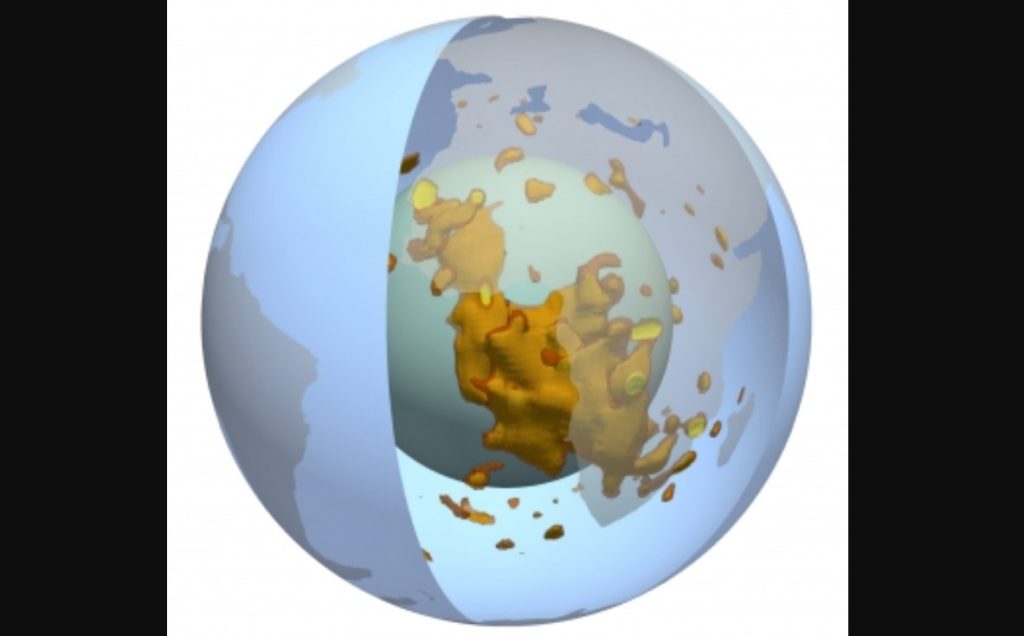
Earth is layered like an onion, with a thin outer crust, a thick viscous mantle, a fluid outer core and a solid inner core. Within the mantle, there are two massive blob-like structures, roughly on opposite sides of the planet.
The blobs, more formally referred to as Large Low-Shear-Velocity Provinces (LLSVPs), are each the size of a continent and 100 times taller than Mt. Everest. One is under the African continent, while the other is under the Pacific Ocean.
Using instruments that measure seismic waves, scientists know that these two blobs have complicated shapes and structures, but despite their prominent features, little is known about why the blobs exist or what led to their odd shapes.
PROTECT YOUR HOME AND CAR WITH THE BEST LIGHTNING AND EMP PROTECTION AVAILABLE…
Arizona State University scientists Qian Yuan and Mingming Li of the School of Earth and Space Exploration set out to learn more about these two blobs using geodynamic modeling and analyses of published seismic studies. Through their research, they were able to determine the maximum heights that the blobs reach and how the volume and density of the blobs, as well as the surrounding viscosity in the mantle, might control their height. Their research was recently published in Nature Geoscience.
The results of their seismic analysis led to a surprising discovery that the blob under the African continent is about 621 miles (1,000 km) higher than the blob under the Pacific Ocean. According to Yuan and Li, the best explanation for the vast height difference between the two is that the blob under the African continent is less dense (and therefore less stable) than the one under the Pacific Ocean.
PROTECT YOUR HOME AND CAR WITH THE BEST LIGHTNING AND EMP PROTECTION AVAILABLE…
To conduct their research, Yuan and Li designed and ran hundreds of mantle convection models simulations. They exhaustively tested the effects of key factors that may affect the height of the blobs, including the volume of the blobs and the contrasts of density and viscosity of the blobs compared with their surroundings.
They found that to explain the large differences of height between the two blobs, the one under the African continent must be of a lower density than that of the blob under the Pacific Ocean, indicating that the two may have different composition and evolution.
“Our calculations found that the initial volume of the blobs does not affect their height,” lead author Yuan said. “The height of the blobs is mostly controlled by how dense they are and the viscosity of the surrounding mantle.”
“The Africa LLVP may have been rising in recent geological time,” co-author Li added. “This may explain the elevating surface topography and intense volcanism in eastern Africa.”
PROTECT YOUR HOME AND CAR WITH THE BEST LIGHTNING AND EMP PROTECTION AVAILABLE…
These findings may fundamentally change the way scientists think about the deep mantle processes and how they can affect the surface of the Earth. The unstable nature of the blob under the African continent, for example, may be related to continental changes in topography, gravity, surface volcanism and plate motion.
“Our combination of the analysis of seismic results and the geodynamic modeling provides new insights on the nature of the Earth’s largest structures in the deep interior and their interaction with the surrounding mantle,” Yuan said. “This work has far-reaching implications for scientists trying to understand the present-day status and the evolution of the deep mantle structure, and the nature of mantle convection.” [Nature, ASU]
StrangeSounds.org has been banned from ADS NETWORKS! CLICK HERE TO DONATE AND SUPPORT ME, MY WORK AND MY WEBSITE!
NOW PREPARE FOR THE NEXT NATURAL DISASTER AND EMERGENCY:
PROTECT YOUR HOME AND CAR WITH THE BEST LIGHTNING AND EMP PROTECTION AVAILABLE…
DRINK CLEAN WATER USING THE BEST HOME WATER FILTER AROUND…
You should really subscribe to QFiles. You will get very interesting information about strange events around the world.



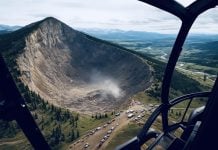

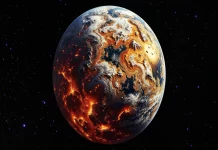
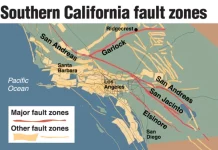
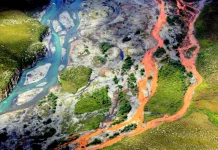
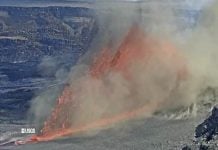

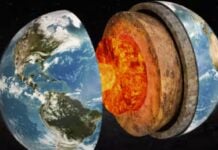

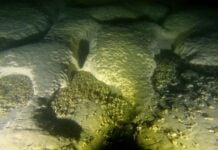

Did we discover the earth’s toilet?
They are the pillars under our Flat Earth…no core, no ball, not “blobs”. Everything you have ever been told is a lie, and I mean EVERYTHING.
Meant to say “those presumed ACTIVE Volcanoes in Africa” on earlier post. Correction: Of 6 they MIGHT categorize as “active” in the last 2 decades, Nyamuragira in the Congo region did have activity last year and several times in the past 2 decades. Nyiragongo has an active lave lake.
The article quotes: “elevating surface topography and intense volcanism in eastern Africa.”
My focus is a reaction to INTENSE VOLCANISM in Eastern Africa caused by the “BLOB”.
Only 2 of 6 have any activity at all that may or may not have anything to do with this blob, be it from 2012 or from 2002 to present.
Nyiragongo and Nyamuragira are on the east of Congo, nearing Lake Victoria on the map, separated from that by Tanzania and Rwanda.
Ol Doinyo Lengai erupted a cooler carbonatite lava in 2007, and baffled those in the field of study. Its Continental regional proximity to Nyiragongo and Nyamuragira should be of interest, and consideration of those in the study should have factored this in the blob hypothesis, it seems to me.
Allegedly, some 185 volcanoes are presumed in Africa. most on the East to Northeast African region, 31 in Kenya and 77 in Ethiopia.
I doubt that this blob will have anything to do with creating 185 ACTIVE volcanoes in Africa when it can barely be involved with 2 out of 6 that may be considered thus. I stand corrected on the 2 that could have been cited, and the 6 overall that can be actually placed as active at all in the last 20 years.
Since no one else corrected me, I had time to double-check and corrected both my typo and mistaken memory on the topic rather than just doing a quick search look up to verify. Had an appointment to keep and I skipped the verification and spell-check / clarity review of what I wrote in in my impatience. Apologies. Thanks.
How can we be sure that one of the blobs is not in fact Victoria Newland?
Yuan has no clue, so he fabricates mythology. Follow the illogical hypothesis of the video, and you will conclude that all of those presumed hundreds of volcanoes in Africa…oh wait, name 1…oops…guess they ain’t going to erupt if they don’t have them after all. Hmmn.
Next, they’ll tell us the blob is an underworld civilization.
In Archaeology decades ago, Leakey used to find corpses under less than a single inch of soil, wet his finger, and declare such and such was over a million years old. The media (be it Time et al.) believed him at his word, and (word was, probably true) he’d go off and laugh his rear end off that they believed it. How much dust has settled on Earth in the expanse of a projected 1.24 million years? Have an idea of the real answer, and you can see the humor if you are among the informed or literate enough to do the calculations yourself.
Maybe Yuan is doing the same? The joke is on the gullible.
Would NOT surprise me that this is just more of a disinfo campaign on real science for pseudo-science junkies. Very disappointed article was even posted to give Yuan credibility. Good night!